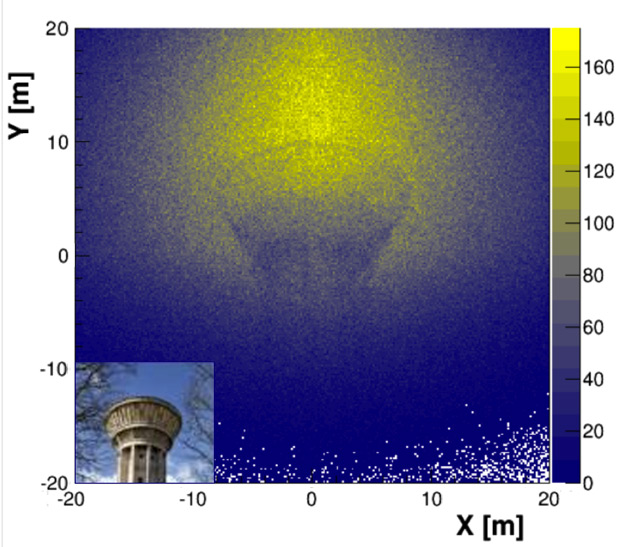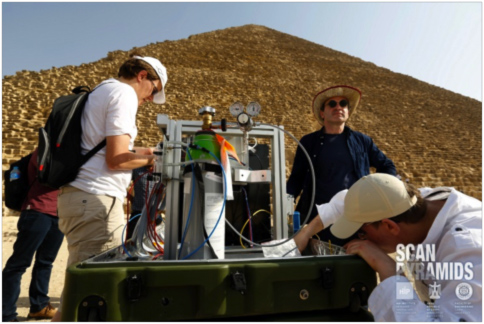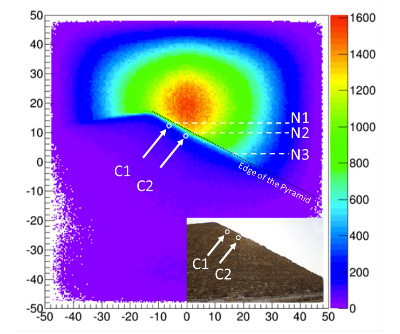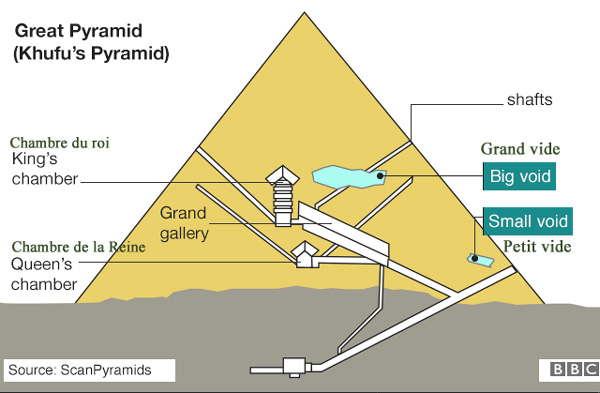Muons to scrutinize the great Cheops pyramid …
Among the various sources of natural radiation to which we are permanently exposed on Earth, we find the « cosmic rays », resulting from the interaction of high energy particles with the atmosphere. These interactions give rise to real cascades of particles forming at ground level a kind of continuous and invisible rain. in these showers of particles, on finds in particular muons, which are elementary particles, heavy and unstable cousins of the electron (family of leptons).
The muons flux at ground level is of the order of 150 per square meter per second, elatively low. Unlike many other particles, muons are very penetrating : about half of cosmic muons can cross a concrete wall 5 meters thick without interacting. Measuring their absorption in an object tallows to determine its density: the higher the number of muons passing through it, the lower the density in the considered direction. This is the principle of the muography (see Fig 1 for illustration) which allows to probe the interior of a structure, where a photograph reveals only its superficial aspect.

Fig 1 : Exemple of muography
Example of muography, in this case a water tower at the CEA-Saclay. The yellow colors indicate a large number of muons, and therefore a small amount of material. The blue colors correspond to a muon deficiency, therefore a greater thickness or density. The dome and the outer pillars are clearly visible, as well as the water in the lower part of the tank. This image makes it possible, for instance, to estimate the quantity of water in the tank.
© CEA-Irfu
On the other hand, and given the limited flow of muons, the required exposure times in muography are much longer, from a few days to a few months depending on the structure studied. But the game is worth the effort: accessing the inside of an object without having to open it, breaking it or even making a hole in it may provide many advantages! For this reason, muons have been used for a few years in a variety of fields, for example to probe the interior of volcanoes, image a damaged nuclear reactor or map the subsoil. In short, muons make it possible to explore places that are difficult to access or in which one do es not want to venture too far.
Another example of muon application is the search for unknown cavities in pyramids. As early as 1968, the American physicist Luis Alvarez tried to detect secret chambers in the pyramid of Khephren in Giza. The technology to detect these precious muons was still rudimentary. Later on, other teams tried to probe these mythical monuments, in Mexico and Egypt, with increasingly sophisticated instruments.

Fig. 2. Telscopes installation in front of the great Kheops pyramid.
One of CEA’s muon telescopes during its installation in June 2016 in front of the north face of Kheops pyramid.
© HIP/ScanPyramids
More recently in 2016, the ScanPyramids mission, coordinated by the Heritage Innovation Preservation Institute (HIP) under the authority of the Egyptian Antiquities Ministry, deployed several muon detectors around the Great Cheops Pyramid. Nagoya University emulsion plates together with a scintillator detector from KEK (Japan) have been scanning the bowels of the pyramid since January 2016. They have already revealed the existence of a void behind the rafters of the North Face. The french CEA (Commissarat à l’Energie Atomique) has also built three muon telescopes, consisting of gaseous detectors, that have been deployed outside to probe additional areas with respect to the Japanese teams (see Fig. 2).

Fig 3. Kheops pyramid ; discovery of an internal cavity
Results of the first Northeast Ridge muography campaign, with the discovery of a cavity (C1) above an already known (C2) cavity.
© HIP/ScanPyramids and CEA-Irfu
These telescopes have already worked for more than 6 months, in particularly difficult conditions (temperatures above 40 ° C, sandstorms, etc …). During their first mission, they revealed the presence of an unknown cavity, located near the Northeast Ridge at about 110 m high, a little above an already known cavity (see Fig. 3 ). Other measurement campaigns have been carried out since, and could help to learn more in the coming months on the construction and architecture of this unusual monument. In the meantime, these results demonstrate the potential of muography. Many manufacturers have already expressed interest in this technique. Other applications are therefore already under development, for example in civil engineering.
Sébastien Procureur Physicist at Irfu (CEA Saclay) and scientific leader of the Scan Pyramids project

October 2017 : a new big cavity discovered
BBC diagram showing the localization of the large volume cavity newly found by the muography. The Great Pyramid of Kheops contained already three large chambers and a series of passages, the most impressive beeing a large gallery 47 meters long and 8 meters high.
© ScanPyramids/BBC
Scan Pyramids’ exploration of the interior of Cheops continue. Late October – early November 2017 : Newspapers and major television channels report the discovery of a second large volume cavity in the Kheops pyramid. The new cavity would be 30 m long and several meters high.
On March 3, 2023, the discovery of a hidden passage inside the Pyramid was announced. The passage is nine meters long and more than two meters wide.
– ‘Big void’ identified in Khufu’s Great Pyramid at Giza. BBC article